Fun with Phylogenetics
Overview
This teacher resource discusses, outlines and explains the construction of 3-D models of the Tree of Life. These 3-D models are presented as a way to help us understand the complex genetic connections between Life on Earth.
Introduction
Over the past decade or so, biology, in the field of phylogenetic systematics, has been quietly undergoing a revolution not unlike astronomy's Copernican Revolution. Most of us, the truth be told, have failed to fully absorb the implications of the 16th century discovery that "our" earth is not the center of the universe--and fewer of us have recovered from the more recent shock of "billions and billions." Well, prepare yourself for another shock.
Imagine seeing on the Great Map of the Universe one of those "You are here" arrows pointing to a microscopic speck representing our galaxy. Next, recall the poster of a spiral galaxy with another "You are here" arrow pointing to another speck representing our sun. Could we be any more insignificant? Now, thanks to insights gleaned from decoding the RNA/DNA Book of Life, biologists have at last gotten into the spirit of things.
It wasn't that long ago that Baby Boomers were being taught that all living things could be classified as either Plants or Animals. By the 1970's biologists had pretty much realized there were more than two Kingdoms, and the Five Kingdom System (Bacteria, Protista, Fungi, Plants, Animals) was proposed and eventually found its way into the textbooks. Then, after reading just a few pages from the RNA Book of Life, biologists collectively gasped, mouths dropped, eyes bugged out (you get the picture) as they caught a glimpse of the true diversity of life.
So on the Great Tree of Life (the one for earth, anyway) imagine a "You are here" arrow pointing to a barely discernable speck labeled "Primates." Get out your microscope and dial in the 10x objective for 100x power. Note the tiny branch labeled "Hominidae" that includes all the Great Apes. Add a drop of oil and switch to 1000x. On the left you'll see the twig labeled "Homo," the genus containing all humans--the bipedal apes. There's a lot of dead wood here-- Homo antecessor, Homo cepranensis, Homo erectus, Homo ergaster, Homo floresiensis, Homo georgicus, Homo habilis, Homo heidelbergensis, Homo neanderthalensis, Homo rhodesiensis, Homo rudolfensis, and probably a few more yet to be discovered. Many were "done in" in one way or another by other species of Homo in a process that lead to there being only a sole surviving member of the genus: Homo sapiens.
To see more, move over to the electron microscope. Crank up the power until you can see the hair-like branch labeled "Homo sapiens." Turn up the power up to maximum. Note near the tip is a thin, black band. On your screen the H. sapiens branch appears to be about 4 cm long and the band at the tip is about 1 mm wide--about the width a dull pencil might make. It is within this band that all of human history is contained. Every human we know by name lived and died (or soon will) within this band.
Making 3-D Models to Aid in Understanding the Tree of Life
It is difficult to grasp this view of life--life's enormous diversity and age. We need help. One aid to understanding is to construct 3-D models of the tree of life. One model would show the Big Picture, including the 3 Domains of Life: Bacteria, Archaea, and Eukaryota along with the major divisions of each. This model would contain over 50 terminal branches. One of the terminal branches would be "Viridiplantae," the green algae and green plants. Another would be labeled the "Fungi/Metazoa Group." The metazoans (the multicellular animals) it turns out, are not so different from fungi as to warrant a separate division of their own--another blow to our collective ego. Of the still over 50 remaining divisions, note that each is as genetically different from the other as plants are from the fungi/animals.
Project Content
As a mere science buff, I decided to make models just for the fun of it--it was too good an idea and somebody needed to do it. Science educators and students will have even more reason to make models. If you're an educator, point out what a great science project this would be (or projects as 8 models are suggested below, but hundreds more are possible). If necessary turn model making into a class project. Not only would the class making the model(s) learn something, but kept on display, all the classes that follow would get an eye full and maybe make a few new neural connections. Just because your textbook is 10 years outdated, that doesn't mean your teaching needs to be.
Model Making Overview and Discussion of Possibilities
See some possible ToL models below
- To make the Domain ToL, you will start with a bundle of 56 wires and bind them at the base--the beginning of life about 4 billion years ago (bya).
- The model should show time by length of wire, so let's make the wires 40 cm long or 10 million years per millimeter.
- Divide the wires into two main branches: 22 for Bacteria and the remainder for the Archaea and their later descendants, the Eukaryota, and split them off very near the base as these two domains split off quite early on (about 3.6 to 3.9 bya). About half way out on the Archaean limb (2.1 bya), the Eukaryota would split off and, following the invention sexual reproduction (1.2 bya), diversify into the protists and later into multicellular life.
- Pull out individual wires at the appropriate point, add labels (in the form of leaves of course) to the ends of each wire to identify the group, and you'll have a descent model of the tree of life. You could also use wires of different colors to indicate that a group is photosynthetic, is an extremophile, or lives in water. The base of the tree should be wrapped in red tape to show that early life probably lived under conditions we would regard as extremely hot.
- Then you could make a Eukaryota Tree of Life showing the 30 main branches and the divisions of each. Here, instead of "Fungi/Metazoa Group" you would see three branches: "Choanoflagellida" (Collar flagellates) "Fungi" (including mushrooms, molds, rusts, mildew, smut, yeast), and "Metazoa" (multicellular animals from sponges to vertebrates like you). This tree, also 40 cm tall, would have 78 branches.
- Other Trees of Life could follow: a Metazoan Tree of Life, the Chordate Tree of Life, a Mammal Tree of Life, the Primate Tree of Life, a Hominidae Tree of Life, and finally a Homo Tree of Life.
|
| Began mya |
|
| Height of tree if made at the | |
| centimeters | feet | ||||
| Life | 4000 | 10,000,000 | 56 | 40 | 1.3 |
| Eukaryota | 2100 | 5,250,000 | 78 | 76 | 2.5 |
| Metazoa | 1000 | 2,500,000 | 80 | 160 | 5.25 |
| Chordate | 500 | 1,250,000 | 17 | 320 | 10.5 |
| Mammal | 125 | 312,500 | 22 | 1280 | 42 |
| Primate | 55 | 137,500 | 62 | 2909 | 95 |
| Hominidae | 15 | 37,500 | 33 | 10,666 | 350 |
| Homo | 2 | 5,000 | 12 | 80,000 | 2,625 |
Homo Tree of Life Ideas
- If you were looking at a 40cm Homo Tree of Life, you would have 12 wires, all of which would be less than 40cm except one (Homo sapiens).
- Homo floresiensis would almost be 40 cm, being only a couple of millimeters short of the present before going extinct, while Homo habilis would be a short branch terminating near the base.
- On the Homo sapiens leaf you could make a 1-mm band to represent human recorded history.
- Also impressive would be the fact that if you were to have cut the Homo branch from a Tree of Life made at the same scale (1 mm = 5000 years), that tree would be 800 meters (2,625 feet) tall, twice the height of the Empire State Building and large enough to provide shade for a small town. Imagine a Tree that size and trying to find the one leaf, among the millions, that represents our species. Welcome to the new biology.

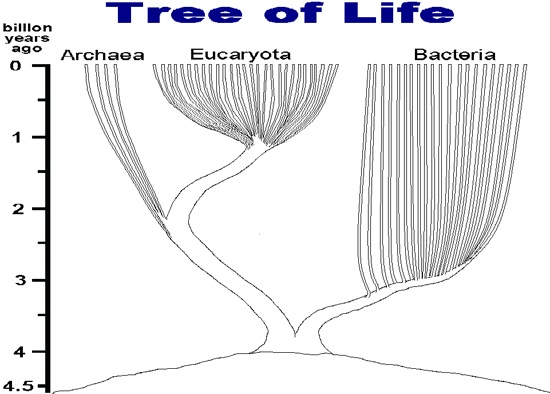
Copyright 2004 Eric Lee
How I Constructed my ToL Models
Preparing Wires to Use as Branches
Here's how I made my first tree of life.
- First I worked on creating the wires to represent different branches. I had the following:
- 12 green coat hangers for the photosynthetic bacteria, protists, and plants
- 12 red hangers for the extremophiles
- 24 blue hangers for aquatic groups
- 12 white hangers for those groups who live inside other organisms.
- From each hanger two 40-cm wires can be made by clipping off the hanger part and straightening the wire, then cutting the two wires to length.
- After this process I had:
- 24 green wires for the photosynthetic bacteria, protists, and plants
- 24 red wires for the extremophiles
- 48 blue wires for aquatic groups
- 24 white wires for those groups who live inside other organisms
- I then took 8 blue, 8 red, 3 green, and 3 white rods and taped them together temporarily in a bundle to represent Bacteria. Four red wires represent the archaeans.
- The remaining wires (18 blue, 0 red, 6 green, and 6 white) where made into another bundle to become the eukaryotes.
- I then put some glue (Goop) on the ends of the wires (about 3/4 inch on one end) and wrapped all the wires tightly at the glued end with black electrical tape. Tape alone would work, but the glue prevents the branches from rotating later on if bumped.
Making the Base of the Tree Model
I designed two different bases. The sketch below shows the construction details and the pictures below show the completed model. The base is made from 1x2" lumber available from Ace or any lumber store.
- The Domain Tree of Life: For this tree model the base is 17" x 11" or the size of two sheets of paper. A thin board covers the rectangular area at the bottom of the stand to display information about the tree. The stand needs to have enough room for two 8.5x11 sheets of paper, becuase you will want lots of room to display information about the model.
- For other trees showing smaller branches, a base of 8.5" x 11" may be preferred if one page is sufficient to display the information you want. This will also reduce the area needed to display the models (something to consider).
- As lumber may vary slightly, exact dimensions are not given for each piece. The top could be cardboard, although for durability I cut some old 1/8" paneling into 17x11 and 8.5x11 pieces.
- Either way, glue the boards together (if you don't have clamps, at least wrap the edges tightly with electrical tape until dried), then glue on the top.
- The clamp part needs to have two holes drilled in it the size of the screws used, then pilot holes should be drilled in the frame. Screw the clamp on and drill a 7/8-inch hole where the two meet (or cut/saw/file one) and your stand is complete.
- Loosen up the clamp, wrap more electrical tape around the base of the tree if necessary, and then clamp the wire bundle tightly in place. You can now start bending the wires into the branches of the Tree of Life.

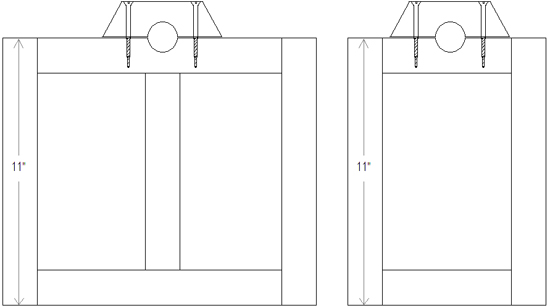
Copyright 2004 Eric Lee
Constructing the Branches
You can now start bending the Bacteria to one side and the Archaea/Eukaryota to the other.
- The bacteria diversified early on at about 3.3 bya, so wrap the first 7 cm of the bacteria branch in red tape and bend off a red wire that will become Aquifecae, the oldest group of bacteria and a thermophile.
- The Cyanobacteria branch off at about 3 bya, or 3 cm above Aquifecae. The other groups, so far as I've been able to gather, branch off either shortly before or after 3 bya.
- After Aquifecae, branch off Thermotogae, Deinococcus-Thermus, Chloroflexi, Bacteroidetes/Chlorobi group, then the Gram Positives.
- After Cyanobacteria would come the Spirochaetes, Proeobacteria, Nitrospirae and Fibrobacteres/Acidobacteria group. Others are something of a guess, but thermophiles and anaerobes are probably older.
- Mitochondria jump over into the Eukaryota around 2 to 1.5 bya, while chloroplasts make the jump into Eukaryota around 1 bya to give rise to the green algae and later to multicellular green plants. These connections are shown by bent wires going from Bacteria to Eukaryota at these times.
- Note: When you think about your "self," think about the 1000 or so bacterial mitochondria symbionts that live in every cell, and consider that for every cell in your body, a 100 or so other bacteria live in or on you. Out of the 56 branches, virtually all the life you can see without a microscope can be found in just two of the branches. It truly is a microbial world of life both inside and outside of what we fondly think of as ourselves.
- Go down the Eukaryota bundle about 12 cm and wrap blue tape on down another 9 cm, or 21 cm from the top when (2.1 bya) Eukaryota split off from Archaea. Below this wrap all the wires in red since the ancestral archaeans were probably thermophiles. Above the blue tape the protists diversified between 10 and 12 cm from the top (the split between plants and fungi/animal occurred last at 1 bya or 10 cm down). The Eukaryota, then, truly burst forth near the top of the tree.
- You can now create labels (leaves) for the branches. Go to the Support Materials section for a link to a page with blank leaves you may use for your tree as well as ready-to-print leaves for the Domain ToL.
- As for what to put on the information sheets for the display, I will leave that as an exercise for the student. You would want to offer more interpretive information than I have stated above.
Below is a detail showing how Chloroplast and Mitochondrion leaves attach to Eukaryota. I made the Bacteria yellow, the Archaea pink and the Eukaryota tan with the exception of green for the viridiplantae.

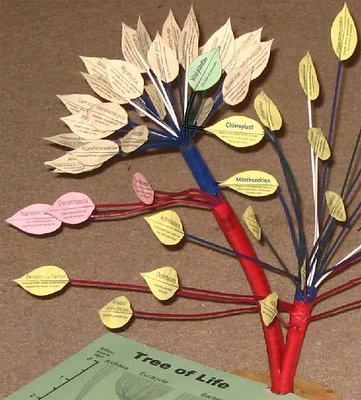

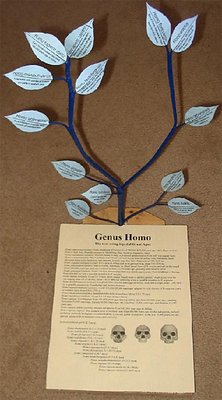
Copyright 2004 Eric Lee
The photograph on the right is an example of a tree using the smaller one-page stand that shows the Homo branch. Due to the angle of the photo Homo floresiensis appears taller than the Homo sapiens sapiens leaf, but is actually 0.3 cm shorter. Blue wires wrapped in blue tape were used. The horizontal line near the tip of the Homo sapiens sapiens leaf represents the span of all human history. As with all Trees, some details are in dispute, and other branchings are proposed. Any one model can only show one "likely story." This model should not be duplicated as-is. Anyone making a model of this branch should do their own research and decide how to deal with current thinking about human evolution in creating their model.
I have made a listing of the 78 groups of eukaryotes complete with notes, but I have not yet made leaves for them. I'm hoping someone will complete this step and make their work available to others (hint, hint). If leaves were available for a tree, making it would be much easier. As for the other trees, I have only made lists of names without comments for the most part. The approximate time for each branching also needs to be determined (The Ancestor's Tale, by Richard Dawkins, contains most of the branching time information needed). Should someone (hint, hint) wish to undertake the research and make the leaves, let me know (to avoid duplication of efforts). Eventually I would like to host all the resources needed to make a variety of trees. I can also foresee someone, a craftsman, making museum quality models, perhaps larger trees showing the domains in greater detail. Of course, having professionals oversee the accuracy of the various models would be great.
Support Materials
- Leaf printouts/templates in image and MS Word format.
- Trees of Life. Here's a list of a few of the possible trees in HTML format. I'm using the GenBank taxonomy, but there are, of course, others that could be modeled, and numerous points are in dispute. Any models will have to evolve to keep pace with the rapid advance of phylogenetic knowledge.
- Historical trees would also be of interest to show how our view of life has changed:
- Aristotle
- Linnaeus
- 5 Kingdom
Physical Materials and Tools
- Vinyl coated coat hangers to use for branches of the tree. (Available at Wal-Mart in various colors at 97 cents a dozen).
- 1 pack (12) green hangers for the photosynthetic bacteria, protists, and plants
- 1 pack (12) red hangers for the extremophiles
- 2 packs (24) blue hangers for aquatic groups
- 1 pack (12) white hangers (the only other color) for those groups who live inside other organisms
- Goop Glue
- Two 3" screws
- Wood for the model's base: 1x2" lumber available from Ace or any lumber store. As lumber may vary slightly, exact dimensions are not given for each piece. One piece should be 17" x 11" (for the Domain of the Tree of Life and other large models). Small models can be made with 8.5x11 pieces.
- Cardboard, or thin (1/8") wood paneling, 17x11 (1 piece for the main model) and 8.5x11 (for as many additional tree models you will make). Will be used in order to cover the base of the models and display information).
- Electrical tape, one roll of black and one package of colored electrical tape.
- Clamps for wood (electrical tape may be substituted)
- Drill to make holes in wood for the clamp, a screwdriver, and a saw.
Learning Resource Information
- ToL Learner Level
- Intermediate
- Advanced
Information on the Internet
- NCBI Taxonomy Homepage Find the GenBank taxonomy here, and lots more.
- Introduction to Systematics What's phylogenetic systematics? Find out here.
- Museum of Paleontology Berkeley's online museum.
- Palaeo Another fun LIFE site.
- The Green Tree of Life To learn more about botanical taxonomy, go here.

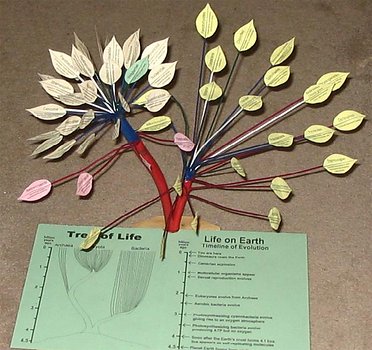

 Go to quick links
Go to quick search
Go to navigation for this section of the ToL site
Go to detailed links for the ToL site
Go to quick links
Go to quick search
Go to navigation for this section of the ToL site
Go to detailed links for the ToL site